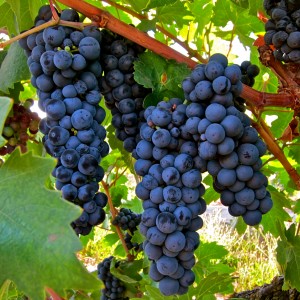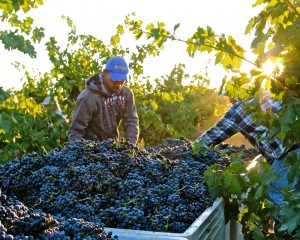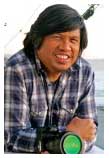Up until only recently, according to wine journalist Rod Byers CWE, Zinfandel has been presented as “the Oakland Raiders of wine… loud, proud, unruly, and unapologetic.”
But at this past January’s ZAP (Zinfandel Advocates & Producers) Grand Tasting, Byers noticed an increased “sophistication” in the Zinfandels. In a report entitled Zinfandel grape comes of age, published this past March 6 in The Union, the Grass Valley (Western Nevada County) daily newspaper, Byers wrote: “None (of the Zinfandels at this year’s ZAP) seemed overly alcoholic, sweet, or rough. Only one could have been considered moderately tannic. The wines were fruity, balanced, and even elegant.”
Which is cool, since this confirms our own observations. Mr. Byers, a Certified Wine Educator who also teaches at Sierra College, has been moderating day-long winemaker seminars at ZAP’s Grand Tasting in San Francisco every year for the past few years. This has put him in a great position to assess the evolution of California’s Zinfandels over the past 22 years.
 ZAP was started up in 1991, says Byers, when “a small band of winemakers were growing increasingly concerned that Zinfandel was in danger of disappearing. Zinfandel, the backbone of the California wine industry for over a century, was falling out of favor with the wine drinking public. Faced with dropping sales growers were yanking out vineyards or budding over to other varieties. Much of what was left was being produced as white-zin. In fact, new wine consumers sometimes thought Zinfandel was a white grape.”
ZAP was started up in 1991, says Byers, when “a small band of winemakers were growing increasingly concerned that Zinfandel was in danger of disappearing. Zinfandel, the backbone of the California wine industry for over a century, was falling out of favor with the wine drinking public. Faced with dropping sales growers were yanking out vineyards or budding over to other varieties. Much of what was left was being produced as white-zin. In fact, new wine consumers sometimes thought Zinfandel was a white grape.”
The issue with White Zinfandel, as Lodi’s grape growers were also discovering, was that demand for grapes to produce this pink toned, fruity style of wine was also beginning to drop precipitously. When grape contracts began to disappear, it was sink-or-swim time for all the growers, big and small – some from families who have been farming in Lodi for over 50 years, some for well over 100 years.
So many of them did what you do when it’s time to make lemonade out of lemons: they applied for winery bonds and began producing their own wines. Klinker Brick, Heritage Oak, Harney Lane, LangeTwins Family, Van Ruiten Family, Mettler Family, and Peirano Estate are just some of the outstanding Lodi wineries that have risen out of those circumstances over the past 20 years.
ZAP, in the meantime, began to attract up to 10,000 Zinfandel enthusiasts at a time to its annual Grand Tasting. Stylistically, according to Byers, many of these Zinfandels followed the style of ZAP co-founder Joel Peterson of Sonoma’s Ravenswood Winery, whose motto was “No Wimpy Wines.” More and more Zinfandels were deliberately scaled to be “brash and irreverent” – very popular among consumers, but less so among more and more critics complaining “that Zinfandel was too tannic, too fruity, too alcoholic, too out of balance, and not food-friendly.”
Just three years ago, for instance, the popular wine columnist Steve Heimoff confessed (in Talkin’ Zinfandel blues), “I haven’t gone (to a ZAP) for years,” while decrying the “fat, extracted, high-alcohol sweet style… clumsy, inelegant, and undrinkable with almost anything, except for that all-purpose food group, ‘barbecue’” – ouch…
“The bombastic, frat-party-gone-wild image might have been useful for establishing an identity for Zinfandel,” comments Byers, “but now winemakers like Peterson prefer to talk about balance, elegance, restraint, and food compatibility.”
Another major development signaling the maturity of Zinfandel, says Byers, was the 2013 ZAP’s inclusion of “a Terroir Tasting Area to compare and contrast flavor profiles between different Zinfandel growing regions like Dry Creek, the Sierra Foothills, or Lodi.” In a ZAP Flights seminar, taking place the day before the Grand Tasting, the Historic Vineyard Society – dedicated to the preservation of heritage vineyards throughout the state – put on a terroir-focused tasting of three of California’s major Zinfandel regions (including Lodi, presented by Turley Wine Cellars’ Tegan Passalacqua).
 With increased sophistication of Zinfandel lovers comes increased appreciation of the specific vineyards from where the finest Zinfandels are sourced. Says Byers, “Perhaps the two wines that impressed me the most were the McCay Cellars Truluck’s Vineyard Zinfandel from Lodi and the Andis Winery Estate Zinfandel from Amador. Both of those wines broke the mold of their regions. While words like rustic and tannic are often attached to the wines of the Sierra Foothills, and raisined and ripe to those of Lodi, both these wines were fruity, stylish, flavorful, and balanced.”
With increased sophistication of Zinfandel lovers comes increased appreciation of the specific vineyards from where the finest Zinfandels are sourced. Says Byers, “Perhaps the two wines that impressed me the most were the McCay Cellars Truluck’s Vineyard Zinfandel from Lodi and the Andis Winery Estate Zinfandel from Amador. Both of those wines broke the mold of their regions. While words like rustic and tannic are often attached to the wines of the Sierra Foothills, and raisined and ripe to those of Lodi, both these wines were fruity, stylish, flavorful, and balanced.”
McCay, of course, is not the only Lodi winery evolving in this fashion. LangeTwins, Peirano, Heritage Oak, and The Lucas Winery, to name just four, have been focused on this balanced, un-Oakland Raider-like style pretty much from the get-go. Although vintage conditions had some something to do with it, even Zinfandels like Macchia’s recently released 2011 single-vineyard bottlings, and Michael David’s 2010 Earthquake, indicate subtle movements towards the balanced style.
One could argue, of course, that Zinfandel came “of age” a long time ago – when wine lovers first began to embrace it wholeheartedly as one of the great varietals of the wine world. But as wine lovers’ appreciation of nuances –especially those related to individual vineyard distinctions – have begun to grow, so has the appreciation of heritage vineyards. This may not keep each and every ancient planting, declining in production, from being pulled out for real and practical reasons. But if anything is going to save them, it’s going to be consumer demand: the willingness to pay more for Zinfandels from vineyards that cost more to maintain.
On the aesthetic side, no longer do Zinfandels need to be “big,” or the opposite of “wimpy,” to be noticed. They just need to be true to their place of origin; or perhaps better, always go great with barbecue!
The featured blog article was first published online at lodiwine.com and is republished here with the permission of ZAP ( Zinfandel Advocates & Producers) and the author, Randy Caparoso, a long time friend of this web site, Wines.com.
Randy Caparoso is a multi-award winning sommelier and restaurateur, founding partner, Roy’s Restaurants and longtime wine journalist, including Sommelier Journal, The Tasting Panel Magazine, San Joaquin Magazine and lodiwine.com. Randy covers the entire West Coast from his home base in the middle of a 50-year old Lodi Zinfandel vineyard.
Caparoso in the recipient of many industry awards, including recognition by the Academy of Wine Communications for Excellence in Wine Writing and Encouragement of Higher Industry Standards, and he is an Electoral College Member for the Vintners Hall of Fame at the Culinary Institute of America, Greystone.
Randy’s blog, Culinary Wine & Food Adventures is one of our favorites. He writes about wine strictly from the perspective of food. To him, wine is a food like a rose is a rose, and his words bring clarity to this concept in new, delicious ways.


